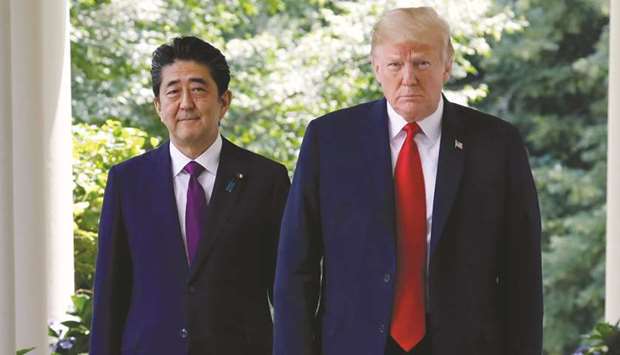Japan is finally stepping into the ring for a fight it had managed to dodge for more than two years: Bilateral trade talks with US President Donald Trump.
The world’s third-biggest economy has a lot at stake in the talks, which are expected to start this week in Washington just as the US’s negotiations with China appear to be winding down. Prime Minister Shinzo Abe is desperate to avoid tariffs or quotas on lucrative auto exports, while Trump wants to crack open Japan’s agricultural market and reduce a $60bn trade deficit.
Abe has poured energy into courting Trump to maintain a strategic relationship that secures his country against potential threats from North Korea and China. But that doesn’t mean Japan will roll over on trade: Abe’s government is determined to avoid giving the US a better two-way deal than the multilateral pacts he’s negotiated with Europe and Pacific Rim nations.
“It’s the US who asked for these bilateral negotiations,” said Ichiro Fujisaki, a former Japanese ambassador to the US, who’s now president of the Nakasone Peace Institute.
“So, it’s the US who should put to us what they want, rather than us offering this and that before being asked.”
The talks add to worries among investors as Trump turns his gaze from China to trade grudges elsewhere. The US leader, who will face questions on his success in rebalancing America’s trade relationships in next year’s presidential campaign, has signalled a willingness to continue market-disrupting tariff threats despite growing economic concerns.
Abe only agreed to bilateral talks after Trump hit Japan’s steel and aluminium exports with punitive tariffs last year and later threatened to impose levies of as much as 25% on all imported cars, including those made in Japan. Trump faces a decision in May on how to proceed with the auto tariffs.
“Japan is now negotiating,” Trump told reporters last month. “They haven’t wanted to negotiate for many years, but now they’re negotiating. It’s called ‘tariffs.’”
Still, Abe’s economy minister, Toshimitsu Motegi, has been able to observe the Trump administration’s previous battles with South Korea, Canada, Mexico and China before sitting down next week with US Trade Representative Robert Lighthizer. In each fight, the US adopted extreme positions that threatened to upend economic ties only to drift toward more modest changes.
Abe has also fortified Japan’s position by sealing trade pacts with the European Union and 10 other partners jilted by Trump when he abandoned the Trans-Pacific Partnership shortly after taking office. Those deals have left US farmers, including beef and pork producers, at risk of losing their 22% share of Japan’s food import market to rivals with lower tariffs.
“For Japan, the government has no reason to hasten, to quickly wrap up the negotiations,” said Junji Nakagawa, a professor who researches trade issues at Chuogakuin University in Chiba prefecture near Tokyo.
“The impetus for wrapping up negotiations quickly comes from the US side, especially agricultural lobbyists.”
The scope of talks will be key. If the US can accept parity with Europe and TPP nations on agriculture – as the two sides suggested in a Sept. 26 joint statement – Abe might settle quickly. Trump is expected to visit Tokyo next month for a state visit with the incoming emperor, Crown Prince Naruhito, and Japan doesn’t want trade disputes marring the pageantry.
“We will further expand trade and investment between Japan and the US in a mutually beneficial manner,” Japanese Finance Minister Taro Asotold the US Chamber of Commerce on Thursday in Washington, citing the September statement.
Problem is, the same joint statement also called for reducing Japan’s trade surplus – and agriculture parity may not be enough for Trump. Abe could dig in to avoid a one-sided deal, especially with his ruling Liberal Democratic Party facing an upper house election in July.
“Trump has this illusion that somehow there is this unfairness because there are Toyotas lined up on the docks of Los Angeles and there aren’t any Fords or GMs on the streets of Tokyo,” said Matthew Goodman, who held National Security Council roles under presidents Barack Obama and George W Bush. “There’s really very few other people in town who believe that this should be a central focus of US-Japan negotiations. But the president wants it.
So it’s probably going to happen.” Japan, which continues to hold out hope for the US’s return to the TPP, could insist on the market access it received under that pact. That means eliminating tariffs on the country’s auto parts, which comprised 6% of its exports to the US.

US President Donald Trump and Shinzo Abe, Japan’s prime minister, walk out of the Oval Office in the Rose Garden of the White House in Washington, DC (file). Japan is finally stepping into the ring for a fight it had managed to dodge for more than two years: Bilateral trade talks with Trump.


